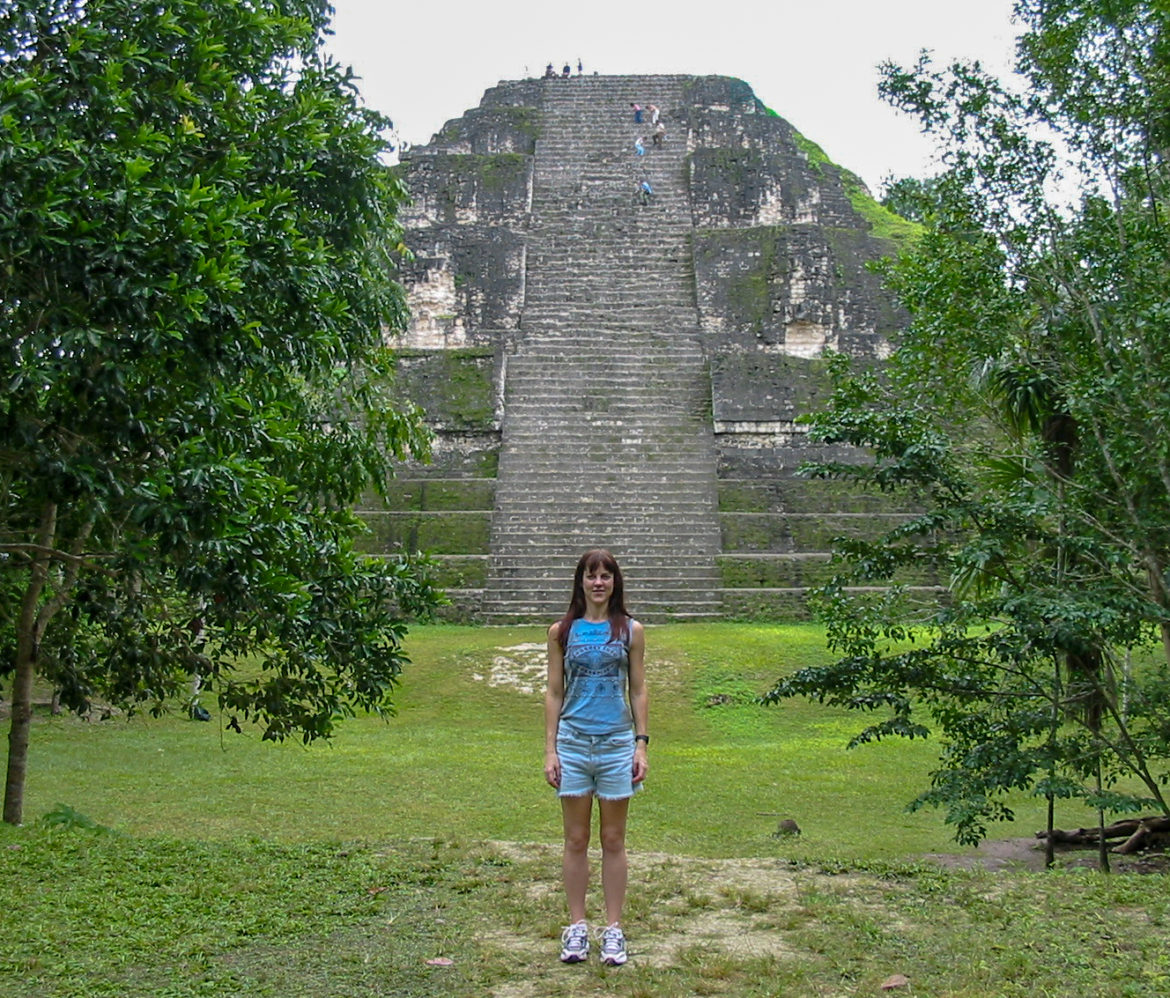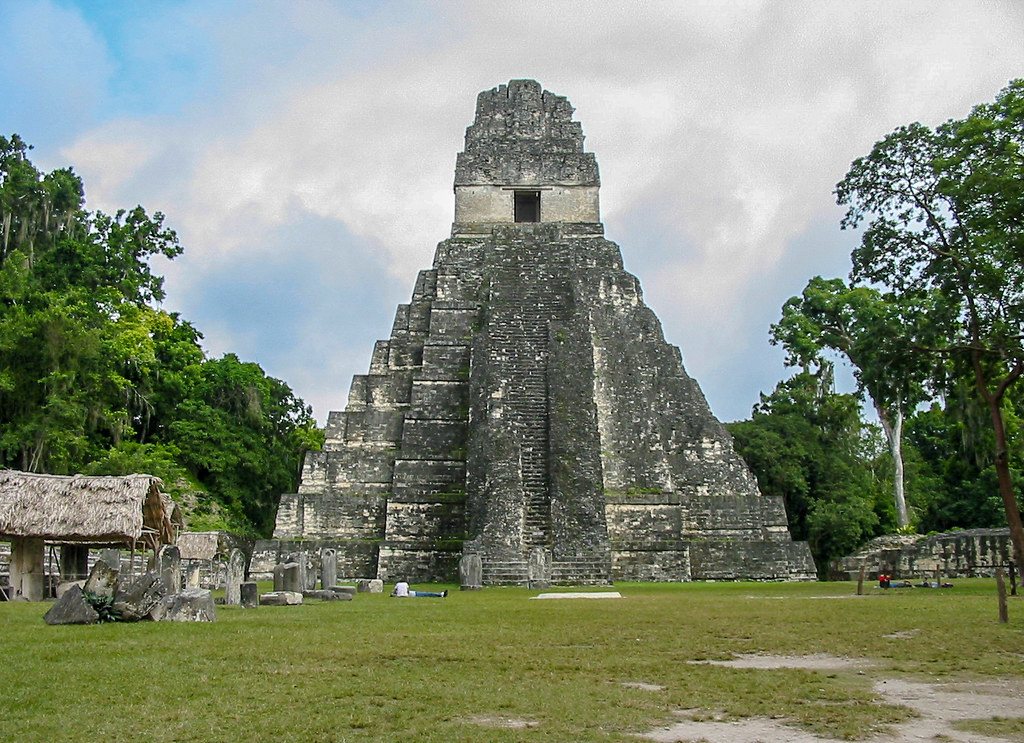The ancient ruins from Tikal National Park are a must-see for anyone interested in the Mayans or archeology. Buried deep in the heart of the jungle, this Mayan Civilization existed from 6th Century BC -10th Century AD. Finally, in the 1950’s the ruins were restored to their current condition. Back in 2002, I took this journey to Tikal, so this is my oldest, vintage blog on my site. Furthermore, I researched and updated Tikal’s current status in 2022, so read on to discover what to expect on a Tikal Mayan Ruins Tour.
Tikal Mayan Ruins History
Tikal lies in the heart of the Maya Biosphere of the Maya Forest of northern Guatemala. The entire Tikal National Park is a UNESCO World Heritage Site. Mayans inhabited Tikal from 6th Century BC -10th Century AD. It’s one of the most important archeological complexes left by the Maya Civilization. This massive park is 60 sq km, consisting of archeological marvels, for example, pyramid temples, plazas, courtyards, palaces, hieroglyphic inscriptions, and stelae. Overall, there are approx. 3,000 buildings making up this treasure trove of Mayan history. Additionally, there are other significant Mayan sites, connected to Tikal, for example, Teotihuacan and Calakmul in Mexico, Copan in Honduras and Caracol in Belize.
Mayan Calendar and Astrology
Many remember the 2012 Apocalypse predicted by the end of the Mayan Calendar Cycle. This was acknowledged by scholars and “New Agers,” because the Mayans were incredibly precise with astronomy and their calendar for predictions. Thankfully, it wasn’t the end of the world, just the end of an era. Furthermore, the Mayans used their pyramids as astrological observatories to calculate their 260-day calendar, meshing with the modern 365-day calendar every 52 years.
Biodiversity of Tikal’s Maya Forest
Another thing that makes Tikal so special, is that it’s both an archeological and natural biodiverse hotspot. Its 57,600 hectares comprise biodiverse ecosystems, for example, wetlands, savannah, palm forests and tropical broadleaf. Furthermore, fauna includes more than 200 tree species and over 2000 plants. Also, the diverse wildlife includes 5 cats, such as the Jaguar and Puma; several monkey species, anteaters and over 300 bird species, including the colorful Macaws and Toucans. Plus, the cute coatimundi’s (aka “hog-nosed coon) intermingle with the tourists at Tikal.
Guatemala’s Tikal Mayan Ruins Tour
Firstly, where to stay? I highly recommend staying in Tikal National Park for convenience and fun. Sunrise and sunset are great times to see the park, therefore, it’s great to know your accommodations are close for early or late journeys. Additionally, most of the hotels in the park offer the Tikal Tours, to learn all you can about the fascinating history. Back in 2002, I loved my stay at the Hotel Jaguar Inn inside the park. It still gets great ratings, however, there are others to research for yourself.
Overall, I recommend at least 2 days here to fully experience Tikal. Maps are essential for navigating the Tikal National Park. Most importantly, knowing the significant landmarks tremendously help so you enjoy and learn the history. For example, I elaborate on these key landmarks: The Great Plaza; Viewpoint from Temple of the 2-headed Serpent; North, South and Central Acropolis; Mundo Perdido and Plaza of 7 Temples.
The Great Plaza
This iconic plaza is the center of life at Tikal with the most impressive monuments among 1.5 grassy acres. Here, stands 2 of the most popular temples in Tikal. The Jaguar Temple is a typical Petan-styled limestone stepped pyramid, 47 m (154 ft) high, with a roof tomb on top. The ruler, Ah Cacao is buried in the temple. Also, the temple’s name refers to a lintel that represents a king sitting on a jaguar throne.
Additionally, the other important temple in The Great Plaza is the Temple of the Masks rising to 38 m (125 ft) high. It precisely aligns with the rising sun. Furthermore, researchers believe that Lord K’awil built the temple for his wife, Lady 12 Macaw, although no tomb was ever found here. Additionally, this is interesting to climb and see the carved masks along the stairway with the wonderful view on top.
Viewpoint from Temple of the Two-Headed Serpent
This is the tallest structure at Tikal, standing at 64 m. Most importantly, its astounding view reveals Temple I, II and III rising out of the lush rainforest. Also, this view is featured in Star Wars Episode IV: A New Hope.
Mundo Perdido or Lost World Complex
This complex is one of the biggest reasons I visited Tikal because of its renowned astronomical reputation. Here’s the largest ceremonial and astrological complex with a large plaza’s Lost World Pyramid. Its ceremonial platform to the west is divided into the High and Low Plazas. The original foundation of the Lost World Complex was an E-Group astronomical complex. Moreover, the east stairway was the observation point, and the 3 temples on the eastern platforms were markers for solstices and equinoxes.
The North Acropolis
Near the Great Plaza, the North Acropolis housed over 100 structures with several stelae in the foreground. Here, the site buried the elite for more than 5 centuries.
Central and South Acropolis
At the Central Acropolis is the Royal Palace, where Mayan Kings lived for over 4 centuries. Also, there are courtyards and housing structures for Tikal’s ruling class. The South Acropolis is next to Temple V, built on a large platform.
Overall, Guatemala’s Tikal Mayan Ruins
Tikal’s Mayan Ruins are some of the most studied archeological sites in the world. Tikal attracted the most prominent thinkers of its time. Therefore, their material provides comprehensive depth from ancient Mayan leaders for the entire empire, for example, scientists, writers, astronomers, mathematicians. Therefore, exploring here is an archeological paradise amidst the lush rainforest.
Read More!
20 Top Things to Do in Historic Antigua, Guatemala
Cacao Tours in Guatemala – The Birthplace of Chocolate








